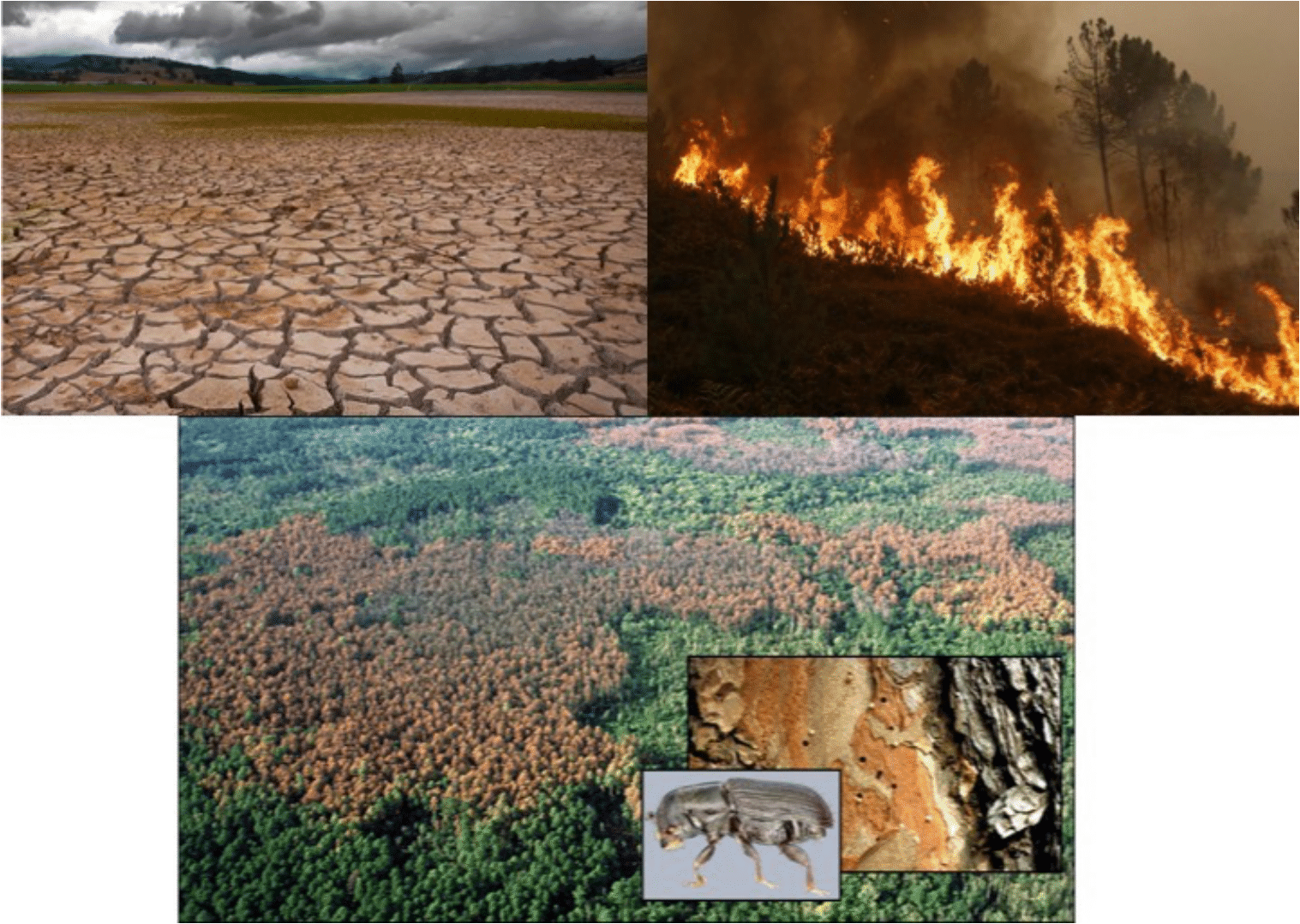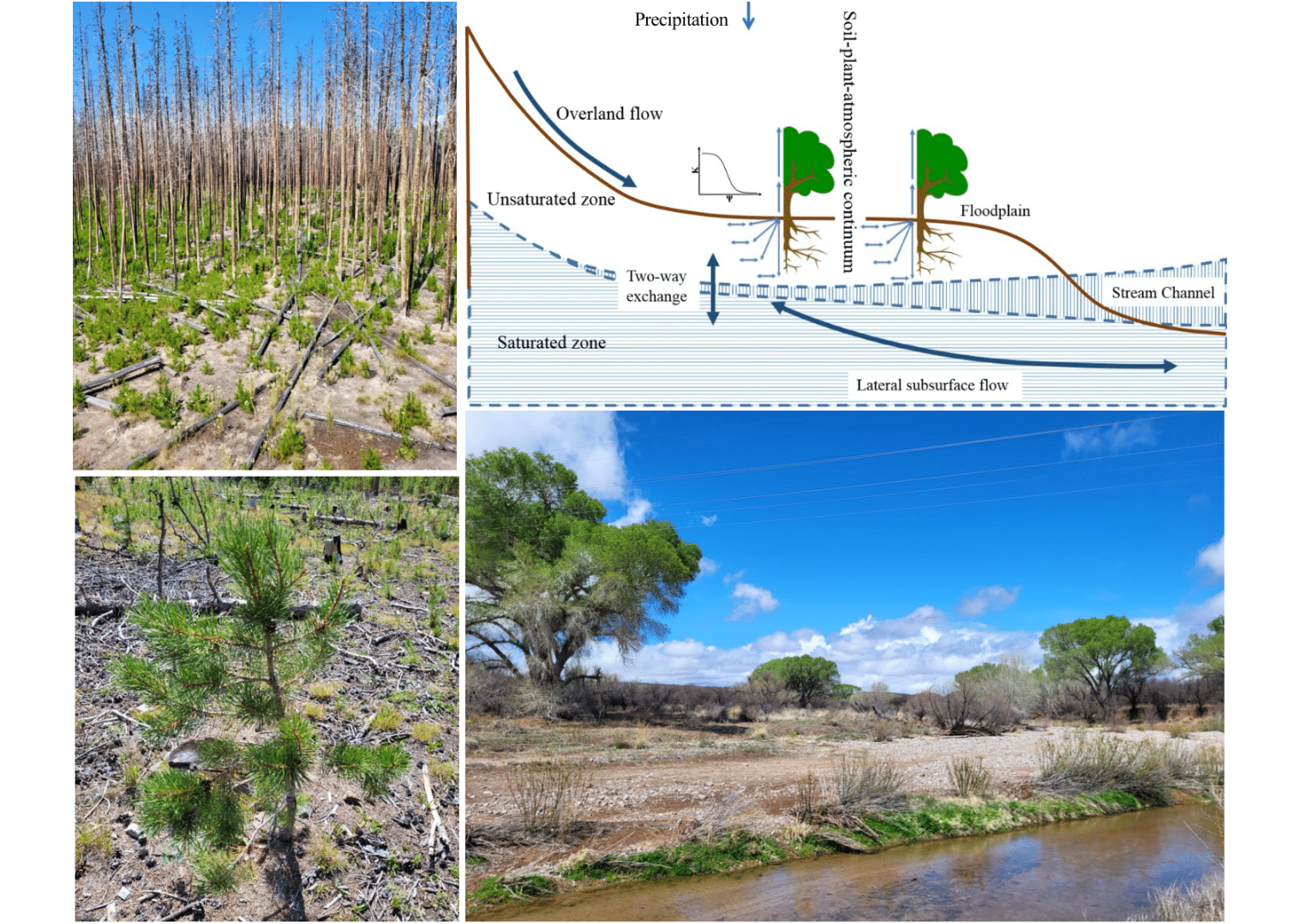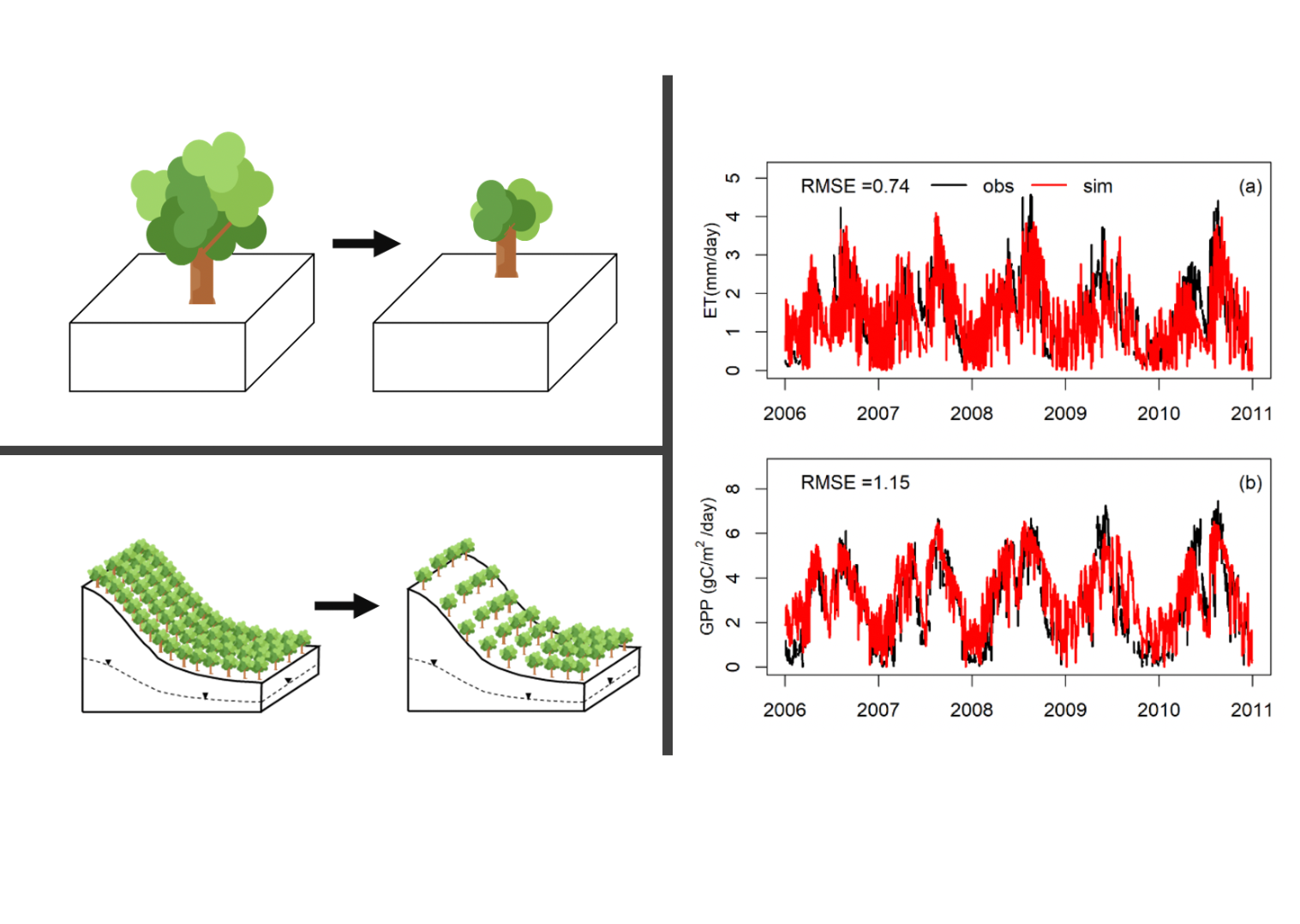
Patterns and drivers of forest mortality, across spatial scales and ecosystem types.
Current and anticipated climate extremes such as drought, heatwaves, and wildfire pose fundamental threats to forest sustainability and the vital services they provide to human society. Widespread forest mortality has occurred across the globe and accurate predictions of forest mortality in response to global environment change are critical for effective conservation. However, our current predictive capacity of observed forest die-off remains limited. Broadly, forest mortality can be influenced by the combination of climatic stress, topography, forest stand properties, and biotic agents such as insects and pathogens. This research theme aims to combine multiple ground-based and remotely sensed observations with mechanistic modeling to gain holistic understandings of the patterns and drivers of forest mortality.

Resilience of groundwater dependent ecosystems during climate extremes and their role in promoting post-disturbance recovery.
Groundwater operates across a range of spatial and temporal scales and can provide sources of plant water that are decoupled and/or asynchronous with the timing of precipitation. Since future climate is expected to have more frequent and intense drought, groundwater can be critical for mediating the impact of extreme drought on plants and for promoting ecological refugia and seed banks, given its potentially large storage and slow response to climate change. However, groundwater processes have been understudied and previously ignored by plant science community. This research theme aims to develop numerical models that couple the three-dimensional subsurface water flows with plant functions and to integrate with extensive field observations to advance knowledge about how groundwater might mediate ecosystem responses to climatic extremes and post-disturbance recovery. We are working on an NSF funded project to quantify the resilience of GDE in response to climate variability and a DOE funded project to examine how groundwater promotes forest recovery after wildfire

Develop science-based mitigation strategies for forest management in an increasingly warming and drying world.
Given recent episodes of forest disturbances, developing effective strategies that mitigate forest vulnerability to climate change has become a major research frontier and a central forest management objective. While the physiological mechanisms underlying drought-related tree mortality are relatively well-understood at the organ or whole-plant scale, few studies have examined how forest conditions might be modulated by the interactions among tree arrangement, topography, and water availability at scales that directly influence management decisions. Forest treatments such as stand density reduction through prescribed forest thinning has been employed to mitigate drought impacts, promote tree- and stand-level growth and forest resilience to disturbances. There is broad consensus that thinning potentially reduces total stand water use, increases the water availability for remaining trees, and reduces inter-tree competition for resources. Yet, few process-based vegetation models explicitly account for competition for water among neighboring trees and the complex terrain. This research theme aims to develop forest management tools to quantify tree mortality risks, physiological functions, and water resources in response to stand structure changes.
--------------------------------------------------------------------------------------------------------------------------------------------------------
Mitigating drought mortality by incorporating topography into variable forest thinning strategiesThomas, A., Kolb, T., Biederman, J., Venturas, M.D., Ma, Q., Yang, D., Dore, S. and Tai, X., 2024. Mitigating drought mortality by incorporating topography into variable forest thinning strategies. Environmental Research Letters.
Tree mortality during long-term droughts is lower in structurally complex forest standsMa, Q., Su, Y., Niu, C., Ma, Q., Hu, T., Luo, X., Tai, X., Qiu, T., Zhang, Y., Bales, R.C. and Liu, L., 2023. Nature communications, 14(1), p.7467.
Integrating forest structural diversity measurement into ecological researchAtkins, J.W., Bhatt, P., Carrasco, L., Francis, E., Garabedian, J.E., Hakkenberg, C.R., Hardiman, B.S., Jung, J., Koirala, A., LaRue, E.A. and Oh, S., 2023. Integrating forest structural diversity measurement into ecological research. Ecosphere, 14(9), p.e4633.
Linking remotely sensed ecosystem resilience with forest mortality across the continental United StatesTai, X., Trugman, A.T. and Anderegg, W.R., 2023. Linking remotely sensed ecosystem resilience with forest mortality across the continental United States. Global Change Biology, 29(4), pp.1096-1105.
Enhanced drought resistance of vegetation growth in cities due to urban heat, CO2 domes and O3 troughsFu, P., Hu, L., Ainsworth, E.A., Tai, X., Myint, S.W., Zhan, W., Blakely, B.J. and Bernacchi, C.J., 2021. Enhanced drought resistance of vegetation growth in cities due to urban heat, CO2 domes and O3 troughs. Environmental Research Letters, 16(12), p.124052.
Groundwater‐Mediated Memory of Past Climate Controls Water Yield in Snowmelt‐Dominated CatchmentsBrooks, P.D., Gelderloos, A., Wolf, M.A., Jamison, L.R., Strong, C., Solomon, D.K., Bowen, G.J., Burian, S., Tai, X., Arens, S. and Briefer, L., 2021. Groundwater‐mediated memory of past climate controls water yield in snowmelt‐dominated catchments. Water Resources Research, 57(10), p.e2021WR030605.
Lateral subsurface flow modulates forest mortality risk to future climate and elevated CO2Tai, X., Venturas, M.D., Mackay, D.S., Brooks, P.D. and Flanagan, L.B., 2021. Lateral subsurface flow modulates forest mortality risk to future climate and elevated CO2. Environmental Research Letters, 16(8), p.084015.
Increasing plant water stress and decreasing summer streamflow in response to a warmer and wetter climate in seasonally snow‐covered forestsChristensen, L., Adams, H.R., Tai, X., Barnard, H.R. and Brooks, P.D., 2021. Increasing plant water stress and decreasing summer streamflow in response to a warmer and wetter climate in seasonally snow‐covered forests. Ecohydrology, 14(1), p.e2256.
Hillslope Hydrology Influences the Spatial and Temporal Patterns of Remotely Sensed Ecosystem ProductivityTai, X., Anderegg, W.R., Blanken, P.D., Burns, S.P., Christensen, L. and Brooks, P.D., 2020. Hillslope hydrology influences the spatial and temporal patterns of remotely sensed ecosystem productivity. Water Resources Research, 56(11), p.e2020WR027630.
Conifers depend on established roots during drought: results from a coupled model of carbon allocation and hydraulicsMackay, D.S., Savoy, P.R., Grossiord, C., Tai, X., Pleban, J.R., Wang, D.R., McDowell, N.G., Adams, H.D. and Sperry, J.S., 2020. Conifers depend on established roots during drought: results from a coupled model of carbon allocation and hydraulics. New Phytologist, 225(2), pp.679-692.
The impact of rising CO2 and acclimation on the response of US forests to global warmingSperry, J.S., Venturas, M.D., Todd, H.N., Trugman, A.T., Anderegg, W.R., Wang, Y. and Tai, X., 2019. The impact of rising CO2 and acclimation on the response of US forests to global warming. Proceedings of the National Academy of Sciences, 116(51), pp.25734-25744.
Plant Hydraulic Stress Explained Tree Mortality and Tree Size Explained Beetle Attack in a Mixed Conifer ForestTai, X., Mackay, D.S., Ewers, B.E., Parsekian, A.D., Beverly, D., Speckman, H., Brooks, P.D. and Anderegg, W.R., 2019. Plant hydraulic stress explained tree mortality and tree size explained beetle attack in a mixed conifer forest. Journal of Geophysical Research: Biogeosciences, 124(11), pp.3555-3568.
Six co-occurring conifer species in northern Idaho exhibit a continuum of hydraulic strategies during an extreme drought yearBaker, K.V., Tai, X., Miller, M.L. and Johnson, D.M., 2019. Six co-occurring conifer species in northern Idaho exhibit a continuum of hydraulic strategies during an extreme drought year. AoB Plants, 11(5), p.plz056.
Dependence of Aspen Stands on a Subsurface Water Subsidy: Implications for Climate Change ImpactsLove, D.M., Venturas, M.D., Sperry, J.S., Brooks, P.D., Pettit, J.L., Wang, Y., Anderegg, W.R.L., Tai, X. and Mackay, D.S., 2019. Dependence of aspen stands on a subsurface water subsidy: Implications for climate change impacts. Water Resources Research, 55(3), pp.1833-1848.
Distributed Plant Hydraulic and Hydrological Modeling to Understand the Susceptibility of Riparian Woodland Trees to Drought-Induced MortalityTai, X., Mackay, D.S., Sperry, J.S., Brooks, P., Anderegg, W.R., Flanagan, L.B., Rood, S.B. and Hopkinson, C., 2018. Distributed plant hydraulic and hydrological modeling to understand the susceptibility of riparian woodland trees to drought‐induced mortality. Water Resources Research, 54(7), pp.4901-4915.
Plant hydraulics improves and topography mediates prediction of aspen mortality in southwestern USATai, X., Mackay, D.S., Anderegg, W.R., Sperry, J.S. and Brooks, P.D., 2017. Plant hydraulics improves and topography mediates prediction of aspen mortality in southwestern USA. New Phytologist, 213(1), pp.113-127.
--------------------------------------------------------------------------------------------------------------------------------------------------------